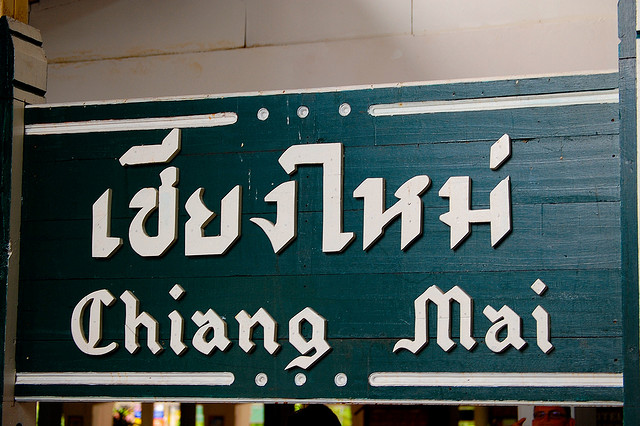Koh Samui, like most major tourist destinations in Thailand, has a high percentage of people who speak at least basic conversational English, making it possible to get around the island quite easily without having to rely on a phrasebook.
That said, learning a little bit of the Thai language will make your life easier – not to mention earn you the appreciation of the local people, who generally respond positively when any foreign visitors tries to speak their tongue.
Learning a language is typically a long-term undertaking, but you can get started with the commonly-used basics right away. Nine times out of ten, a conversation will start with one of the following phrases. If you can master these, you can go a long way towards effectively communicating with Thai people in their language.
1. SAWATDEE…
This is a very common phrase that means “Hello.” There are a couple of important things to know about it, however. First of all, greetings are usually accompanied by a gesture called a wai. To do a wai, you simply press your hands together in a “praying” gesture. If you want to show more respect, you can lift your wai up so that it is level with your forehead.
The other thing to know about greetings – and about the Thai language in general – is that men and women end their phrases differently. Men use “krup” and women use ”kah.” So a man would say “Sawatdee krup,” and a woman would say “Sawatdee kah.”
2. SABAI DEE MAI?
This is a phrase that is used to ask “How are you?” In casual situations, it can be a greeting similar to “What’s up?” The response is easy. Simply remove the question word “Mai.” So if the waitress at a restaurant says to you, “Sabai dee mai kah,” you can respond with “Sabai dee kah/krup,” which means “I’m fine.”
If you forget the “kah/krup,” don’t worry. Most people will not even bother to correct you. However, you will probably get a few chuckles if you’re a man and end a phrase with “…kah.”
3. MAI BPEN RAI
This is a very commonly used phrase – in fact, once you’re tuned in and listening to the language, you’ll hear “mai bpen rai” almost as much as “sawatdee.”
The phrase means “It’s nothing” or “Never mind.” Perhaps a more apt translation is something along the lines of the Australian saying, “No worries.” Thai people are generally very easy-going, and “Mai bpen rai” is a saying that reminds people to go with the flow, no matter what’s happening.
4. NEE TAO RAI?
This question can be useful if you’re off the beaten path and need to buy something, as “Nee tao rai?” means “How much is it?”
Don’t worry if you don’t know your numbers in Thai yet. Most vendors have calculators, and will punch the price in and show it to you. Bargaining is expected at most market settings, so you can type in a counter offer and show it to the vendor.
5. KHORP KHUN KRUP/KAH
This phrase literally means, “Thank you.” You’ll hear it often, but it isn’t really required if you want to be seen as polite. A smile will work just as well. The wai is far more important if you want to show respect.
6. KOR TORD
This phrase means “Excuse me.” You can use it to politely get someone’s attention or to offer an apology if you bump into someone unintentionally.
7. SANUK MAI?
This is a question that’s often uttered among friends. “Sanuk” loosely translates as “having fun.” So “Sanuk mai” means “Are you having fun?” To answer, you just say “Sanuk.” If you aren’t having fun, you can say, “Mai sanuk.”
Like “Sabai,” “Sanuk” is an illustration of the easygoing, fun-loving way of life that most Thai people strive the lead. If you answer “Mai sanuk,” be ready to be whisked off on an eating, drinking, karaoke or shopping session to help you regain your “sanuk-ness.”
8. HONG NAAM YOO TEE NAI?
This phrase doesn’t require much of an explanation – it means “Where is the restroom?” While it won’t be a phrase that you use very often in Thailand, it could come in handy in a pinch – especially if you’re somewhere like Bangkok’s massive Chatuchak Market and can’t find your way to the facilities.
9. AROY MAK
“Aroy” means “delicious” or “tasty.” “Mak” means “very.” When you’re eating out, you’ll hear the question “Aroy mai?” more than once, which means, “Is it delicious?” The polite response is usually to gush over the quality of the food with an enthusiastic “Aroy mak.” It’s ok to lie a little bit and give the dishes an “Aroy,” even if they aren’t mindblowingly flavorful.
10. KHUN PUT PASAH ANGGRIT DAI MAI
“Do you speak English?” If you are obviously struggling with Thai, then the person you’re talking to may try to switch to English (if they’re able to speak it). Or, if you want to initiate the switch to English, you can ask this question. Often, if the person you’re speaking to has no English, they’ll enlist the help of someone else nearby to act as a translator. Even in rural areas, you’ll come across students who have a basic knowledge of English.
Despite the difficulties – such as the different tones and the unusual script – Thai is actually a simple language to learn. The grammar is very simple compared to, say, French or Spanish. Once you learn the words and the tones, you’re already almost 90% of the way to mastering the language.
If you plan on staying in a luxury villa on Koh Samui for the long-term, try to practice every day – putting what you have learned from a book or a language tutor into action in realistic situations.

